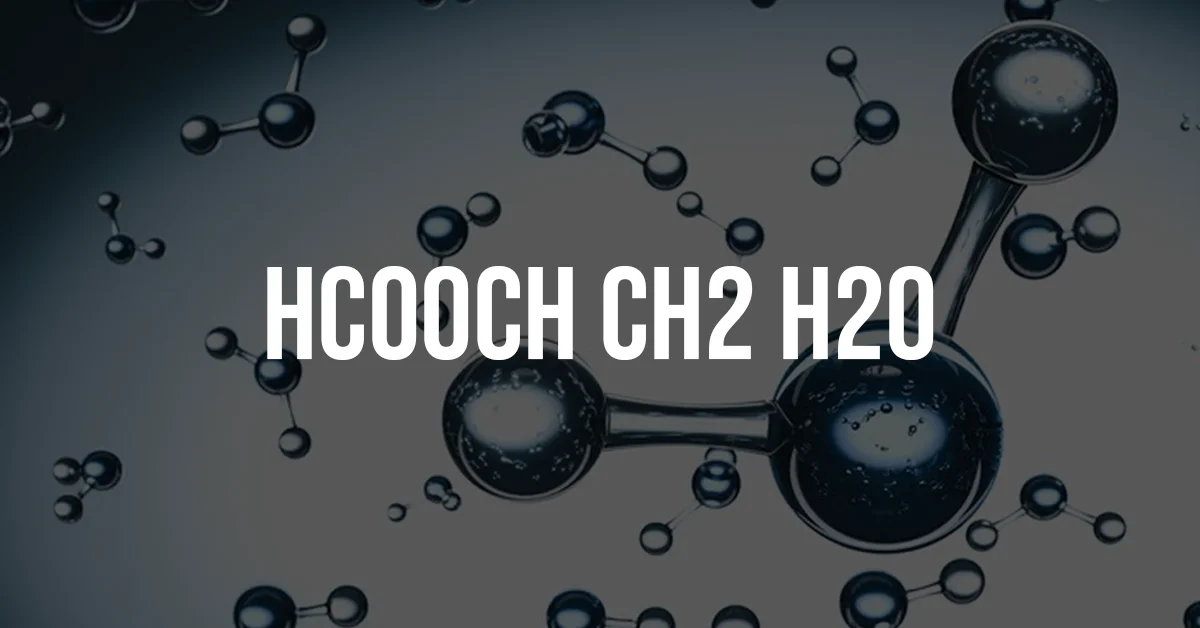In the world of organic chemistry, certain molecular combinations stand out due to their significance in industrial processes and academic research. One such trio is HCOOH CH2 H2O—a combination involving formic acid (HCOOH), methylene group (CH2), and water (H2O). Though simple in composition, this set of molecules presents a foundation for understanding various chemical reactions and mechanisms in both laboratory and commercial settings.
What is HCOOH CH2 H2O?
To grasp the role of HCOOH CH2 H2O, it’s important to break down each component:
- HCOOH: Also known as formic acid, it’s the simplest carboxylic acid, widely found in nature and used in chemical manufacturing.
- CH2: A methylene group, often acting as a bridge or link in organic molecules.
- H2O: Water, a universal solvent and reactant in countless chemical processes.
These three elements are often involved in reactions such as hydration, oxidation, and polymer formation. The combination of HCOOH CH2 H2O suggests scenarios where these entities might interact or co-exist in a reaction medium.
Chemical Significance of HCOOH CH2 H2O
HCOOH: The Reactive Acid
Formic acid (HCOOH) is highly reactive due to its carboxylic acid group. It readily donates a proton (H⁺) in aqueous solutions and participates in acid-catalyzed reactions. Its role in HCOOH CH2 H2O combinations typically revolves around oxidation or acid-base chemistry.
CH2: The Carbon Connector
CH2, while not a standalone molecule, acts as part of larger compounds like methylene bridges or derivatives such as methanol. In reactions involving HCOOH CH2 H2O, the methylene group may come from formaldehyde (CH2O) or methanol (CH3OH), both of which are intermediates in many synthesis pathways.
H2O: The Universal Medium
Water (H2O) isn’t just a solvent. It’s an active participant in hydrolysis, hydration, and equilibrium reactions. In the context of HCOOH CH2 H2O, water often influences solubility, reaction rate, and product formation.
Practical Applications of HCOOH CH2 H2O
Industrial Use of Formic Acid
In industries, HCOOH CH2 H2O combinations may appear in processes like leather tanning, rubber coagulation, and as preservatives. Formic acid is particularly valued for its antibacterial properties and biodegradability.
Synthesis of Methyl Compounds
The interaction of formic acid and methylene-containing compounds can yield formaldehyde or methanol under specific conditions. These reactions often occur in the presence of water, making HCOOH CH2 H2O a possible intermediate system.
Fuel Cell Technology
Formic acid is explored as a hydrogen source in fuel cells. In aqueous systems, HCOOH CH2 H2O might be relevant for controlled hydrogen release, with CH2-based intermediates facilitating energy transfer.
Reactions Involving HCOOH CH2 H2O
Esterification and Hydrolysis
Formic acid can react with alcohols derived from methylene sources (e.g., methanol) to form esters. Water is either a reactant or a byproduct in these cases. A typical esterification might follow:
HCOOH + CH3OH ⇌ HCOOCH3 + H2O
This reversible reaction is a classic example of how HCOOH CH2 H2O might coexist in a reaction system.
Formaldehyde Generation
Formic acid and methylene compounds can also produce formaldehyde under heating or catalysis. Water again plays a key role in moderating the reaction conditions.
Environmental and Safety Considerations
Handling Formic Acid
Formic acid (HCOOH) is corrosive and must be handled with care. In any system involving HCOOH CH2 H2O, safety protocols include proper ventilation, protective gear, and neutralizing agents for spills.
Waste Management
Reactions involving HCOOH CH2 H2O may produce volatile organic compounds (VOCs). Disposal of byproducts should comply with environmental regulations to prevent water and air pollution.
Laboratory Context of HCOOH CH2 H2O
Reaction Medium
In labs, HCOOH CH2 H2O combinations often serve as a reaction medium. For instance, formic acid in water is used for dissolving metal ions, while CH2-containing species modify the reaction pathway or speed.
Analytical Chemistry
These components can also appear in titration, chromatography, or spectroscopy. The presence of HCOOH CH2 H2Oaffects pH, polarity, and detection thresholds in analytical tests.
Future Research and Innovations
With the rise of green chemistry, researchers are examining HCOOH CH2 H2O systems for sustainable processes. For example:
- Bio-based synthesis: Using biomass-derived formic acid and methanol.
- Catalytic efficiency: Developing catalysts that leverage this trio for faster, cleaner reactions.
- Alternative fuels: Expanding use of formic acid-water solutions in portable fuel cells.
These directions highlight the ongoing relevance of this seemingly simple combination in complex, modern applications.
Conclusion
The compound mix of HCOOH CH2 H2O represents more than a list of chemicals—it reflects foundational principles in organic and industrial chemistry. Whether in a lab, factory, or fuel cell, these molecules demonstrate versatile behavior and wide applicability. Understanding their interactions opens doors to safer, more efficient, and more sustainable chemical processes.

